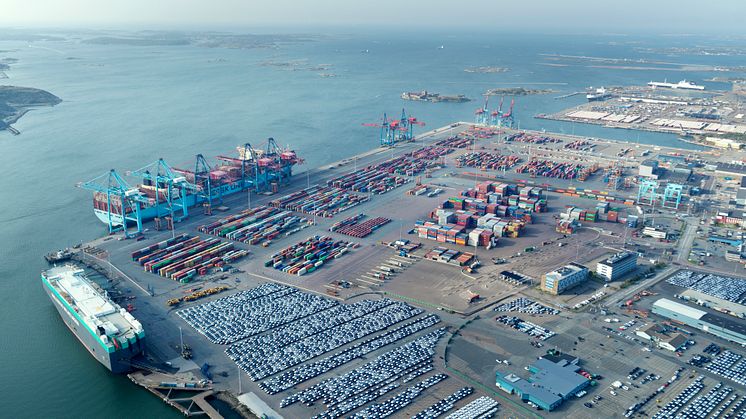
Press release -
Port of Gothenburg first quarter summary – freight volumes increasing
The global logistics system still pressured and continues to be affected by disruptions. While Covid-19-restrictions are lifted around the world, parts of Asia are suffering lockdowns with global repercussions. The Russian invasion of Ukraine affects European as well as global trade. In the Port of Gothenburg however, volumes continue to increase. This is shown in the port's volume summary for the first quarter of 2022.
Russian trade via the port of Gothenburg is historically very small - in 2021, Russia-oriented goods accounted for less than 0.5 percent of the port's handled cargo volume. The lack of Russian ships since Russia's invasion of Ukraine has thus not had a negative impact on the port's volumes during the first quarter of 2022. Instead, volumes have increased.
Together with the Port of Gothenburg’s terminal operators and the goods owners using the port, it has also been possible to manage the effects of the pandemic's first two years, as well as the latest wave in Asia that has led to difficulties, for example in the world's largest port in Shanghai.
”Ultimately, the Port of Gothenburg’s volume upturn is the result of exemplary handling at all levels, from when the vessels arrive in the port area until they leave. When conditions are difficult and vessels call irregularly, extraordinary efforts are required from everyone involved, both on the sea and land side. It is the sum of these efforts we now see in black and white,” said Elvir Dzanic, Gothenburg Port Authority Chief Executive.
In terms of container handling, volumes at the Port of Gothenburg increased for the sixth quarter in a row. 212,000 containers (TEU*) were handled during the first quarter of 2022, which means an increase of four percent. It is also the highest total figure for the period January-March since 2014.
The railway is increasing
A key component of a well-functioning port is the flow between port and inland. In the port of Gothenburg, some 60 per cent of container freight passing through the port is transported by rail. The high proportion of rail freight provides a great climate advantage and is also helps mitigating the current truck driver shortage affecting many other ports. The supply of truck drivers in Europe has been negatively affected by the pandemic, as well as by Russia's invasion of Ukraine.
In 2021, several new rail shuttles were introduced and the number of departures and volumes on existing shuttle routes increased. This can be seen in the figures for the first quarter of 2022, when 126,000 TEUs were transported by rail, which for the period is the highest figure in the port's 400-year history.
Increased ro-ro, passengers, cruise calls and energy volumes - but fewer cars
The port's intra-European ro-ro traffic - which carries rolling goods to and from the UK, Denmark, Germany and the Central European hubs Ghent and Zeebrugge - increased by five percent during the first quarter of the year as 147,000 ro-ro units were loaded or unloaded.
67,000 handled cars during the first quarter of the year is a very good figure historically, but a decrease of seven percent compared to the same period last year which was unusually strong.
On the passenger side in the ferry segment, a clear positive effect of eased travel restrictions can be seen. Passengers have started to find their way back to the ferries - 185,000 passengers means an increase of 177 percent, but is not yet close to normal passenger numbers.
The cruise season started earlier this year than last year at the port, also thanks to lighter restrictions. Two calls were made during the first quarter.
Since very small volumes of energy products from Russia are handled in the port of Gothenburg historically, the total lack of Russian product has not meant any setback for the port's energy volumes. Instead, the volume handled has increased slightly, from 5 million tonnes to 5.3 million tonnes in the first quarter of the year - an increase of five percent compared to last year.
Port of Gothenburg freight volumes, Q1 2022
Jan-March 2022 | Jan-March 2021 | Comparison % | |
Containers, TEU | 212,000 | 204,000 | 4% |
Rail, TEU | 126,000 | 116,000 | 9% |
Ro-ro units | 147,000 | 140,000 | 5% |
New cars | 67,000 | 73,000 | -7% |
Ferry passengers | 185,000 | 67,000 | 177% |
Cruise calls | 2 | - | - |
Energy products, (million tonnes) | 5,3 | 5,0 | 5% |
* TEU = Twenty-foot Equivalent Unit).
Topics
Fact file: Port of Gothenburg
The Port of Gothenburg is the largest port in Scandinavia. Around 30% of Swedish domestic and foreign trade passes through the Port of Gothenburg and around 50% of all container traffic. The port is a full-service port, and offers industry guaranteed, climate-smart access to the whole world. Direct services to key markets ensure highly efficient, sustainable, and reliable transport 24 hours a day, 365 days a year. The focus is firmly on sustainability, innovation, and digitalisation in a concerted effort to maintain the ongoing development of climate-efficient freight transport and calls by vessels. With 25 rail shuttles offering daily departures, companies throughout Sweden and Norway have a direct, climate-neutral service to the Port of Gothenburg. The port operates energy product, vehicle, ro-ro, container, and passenger terminals and has 22,000 employees.
Follow us on:
Facebook
Instagram
LinkedIn
Twitter
www.portofgothenburg.com


